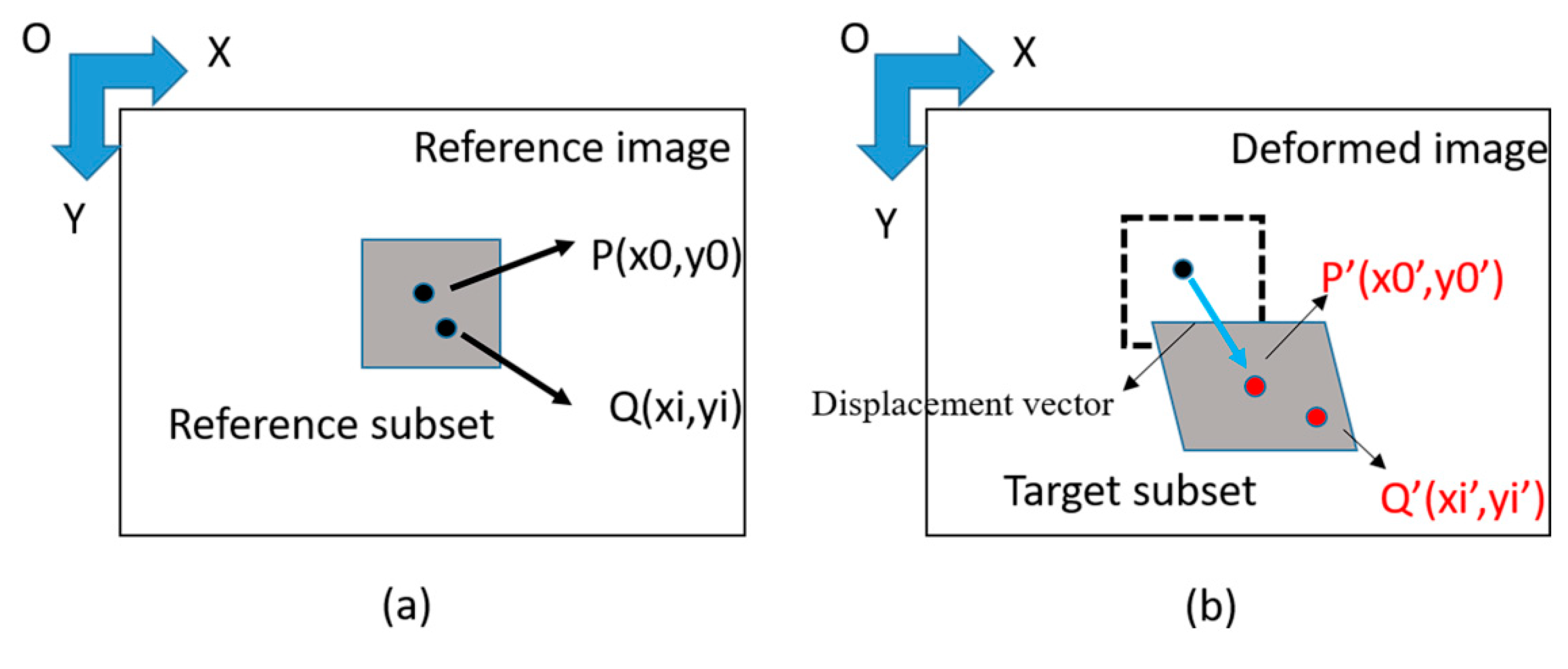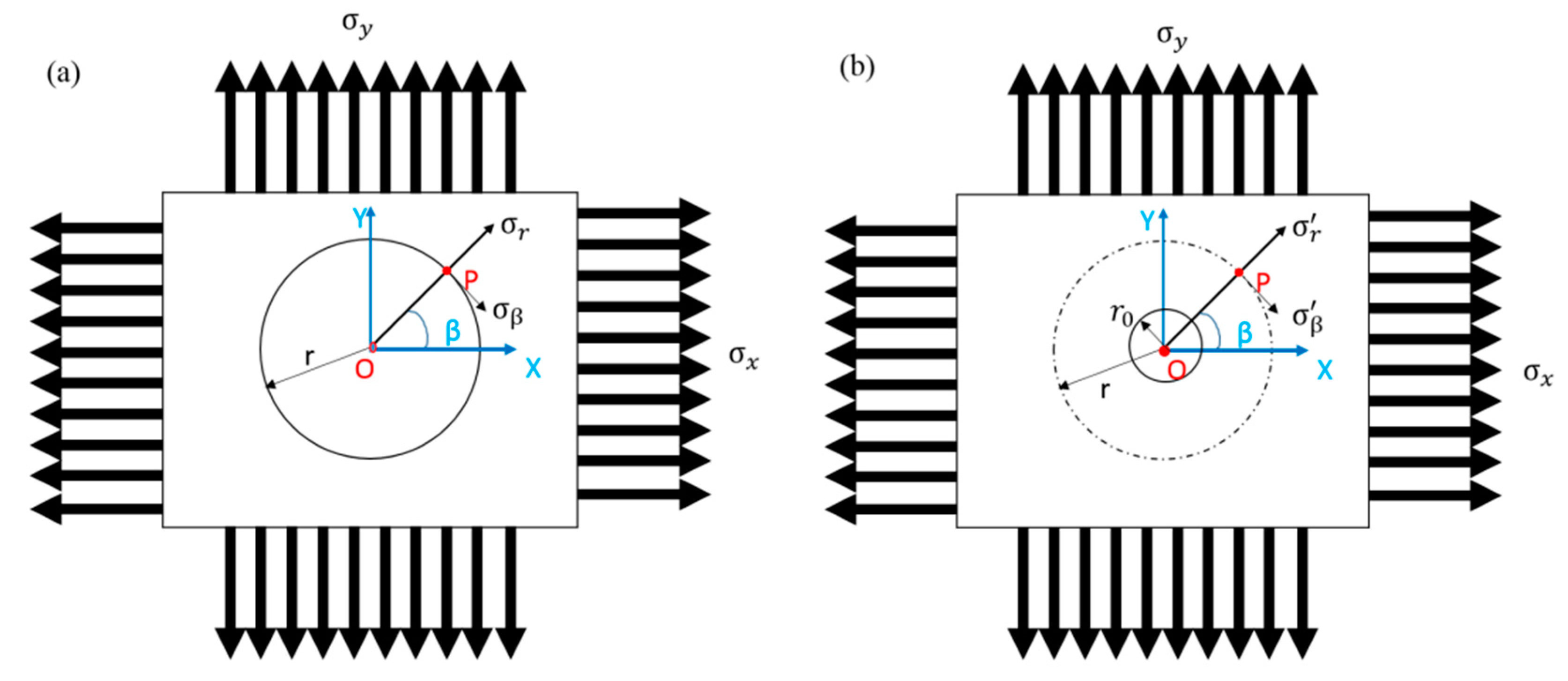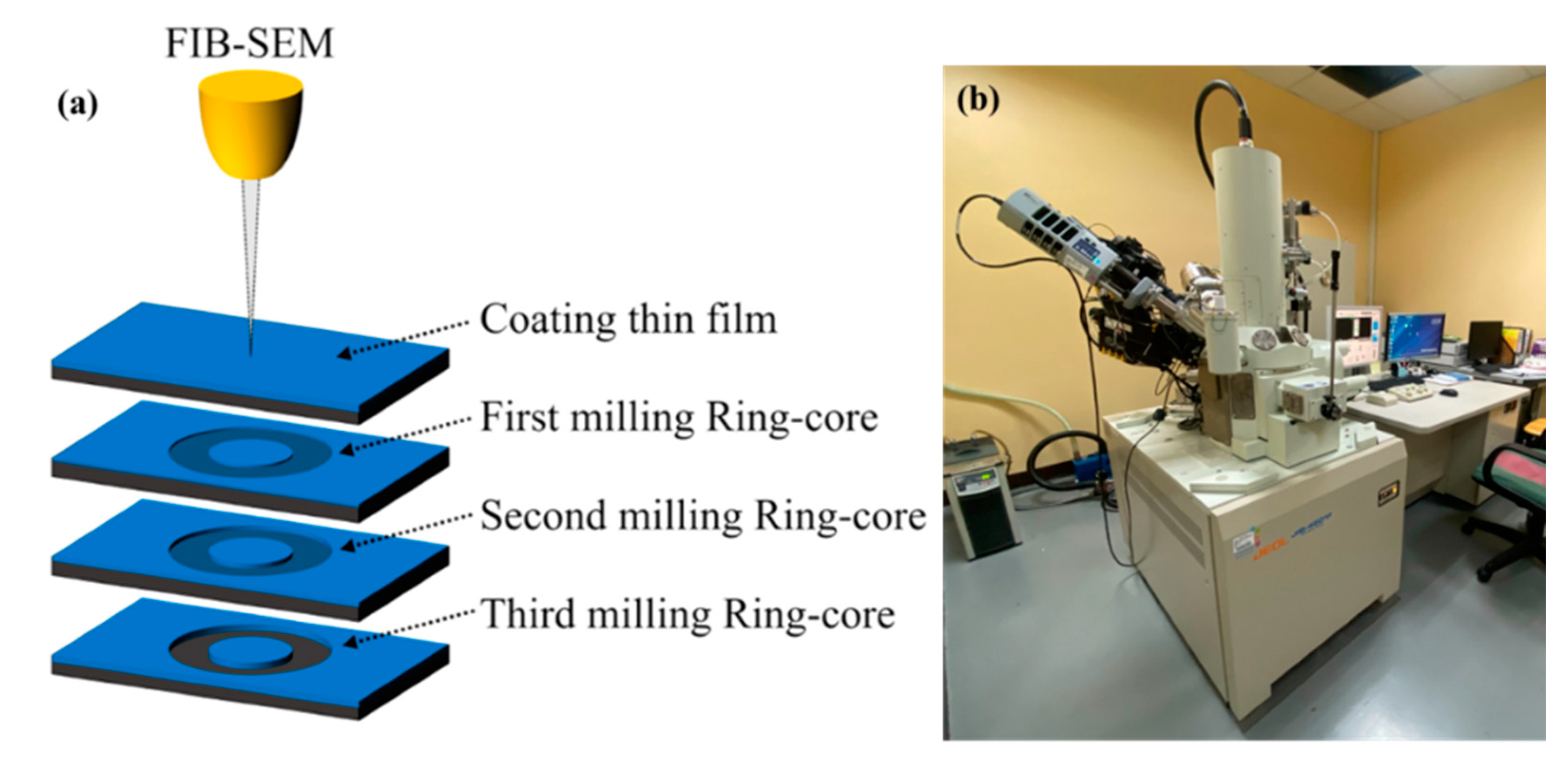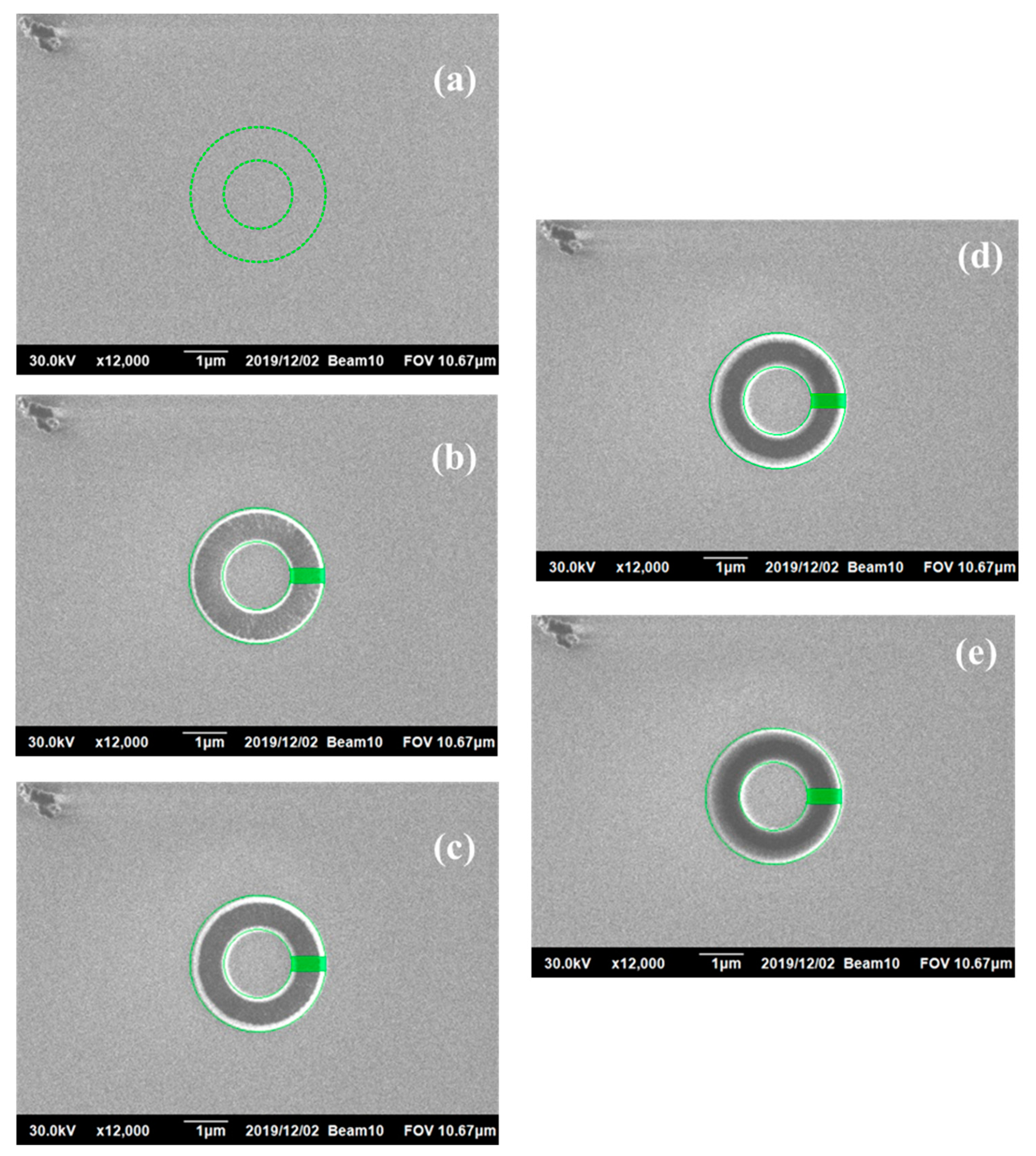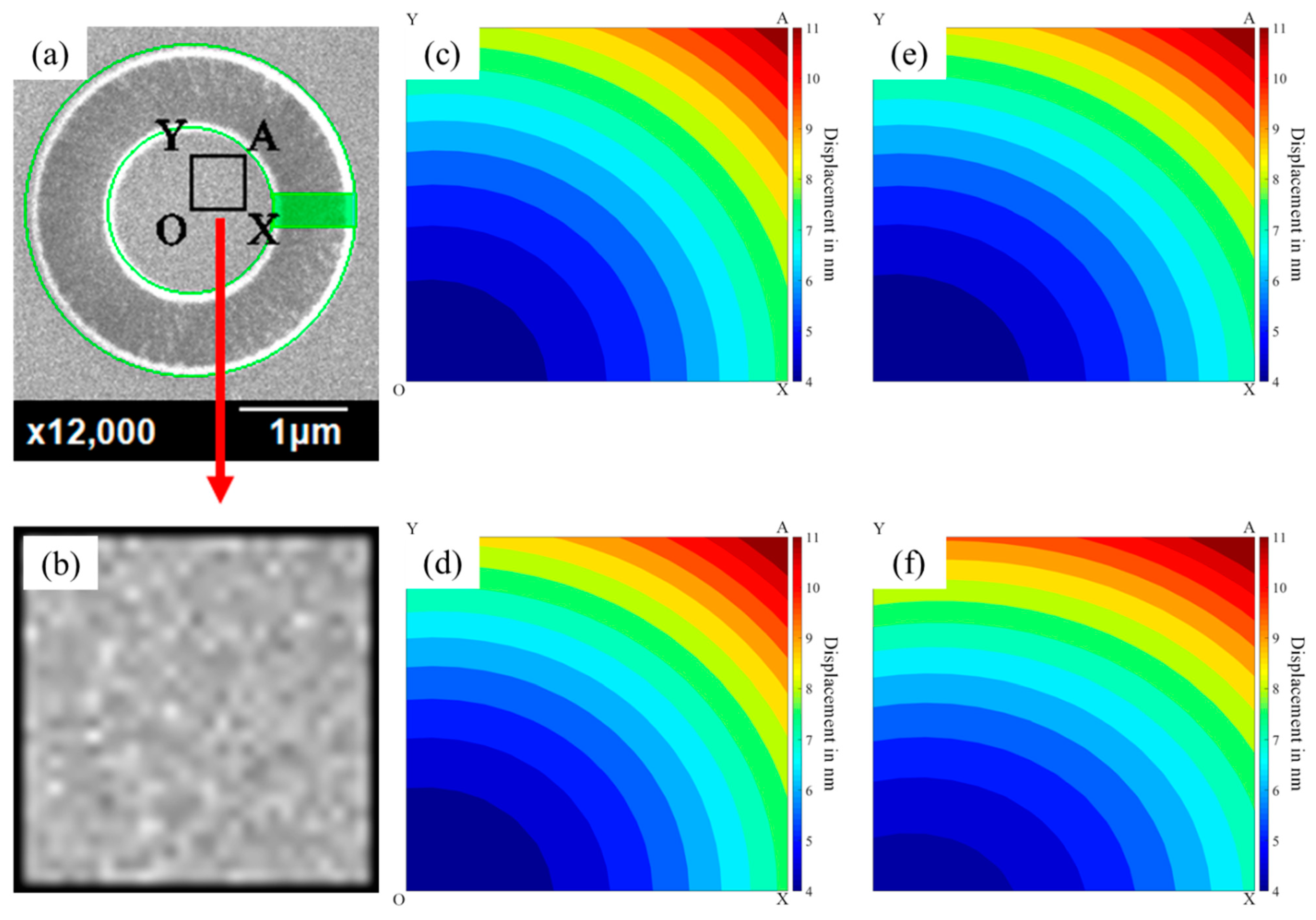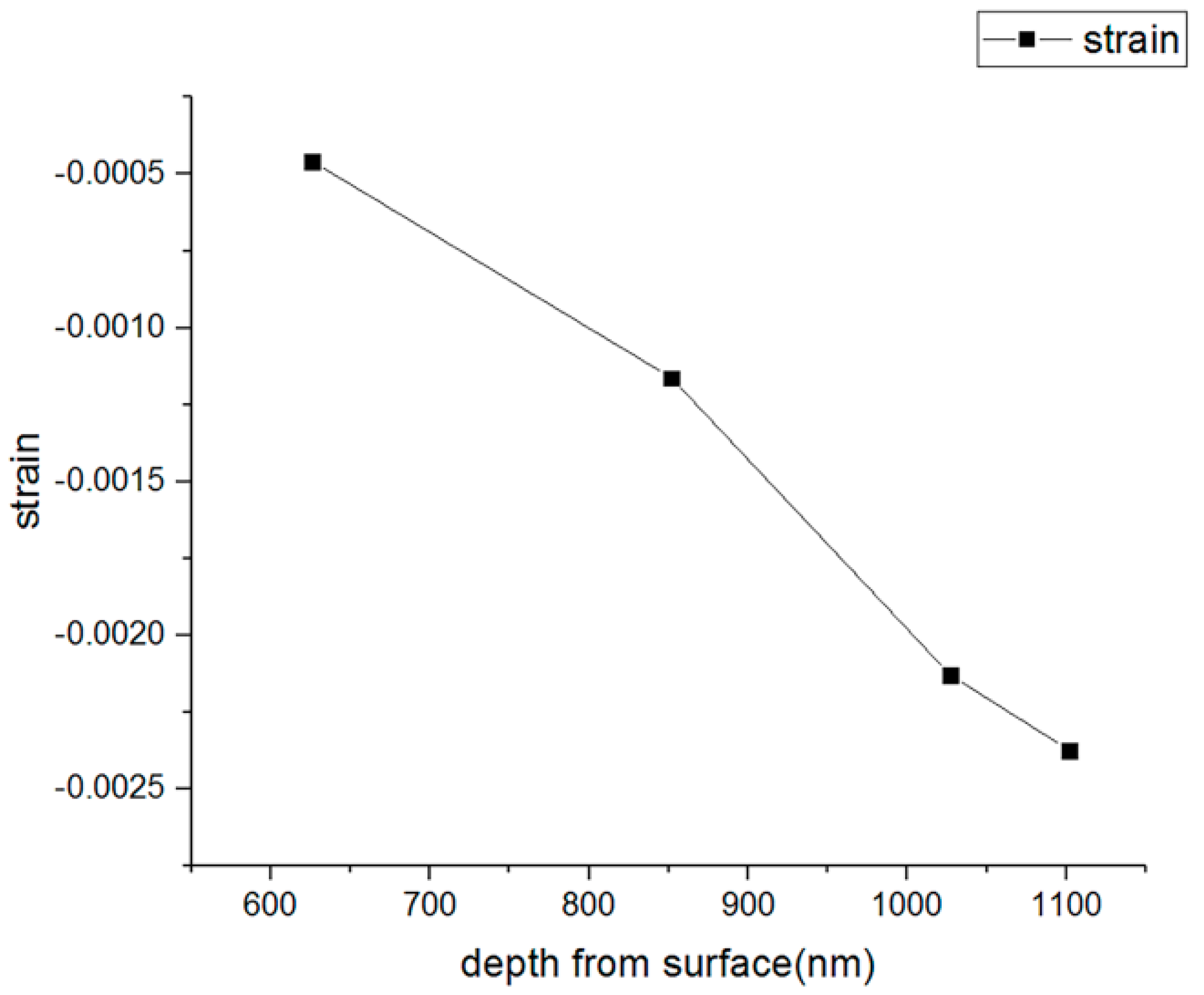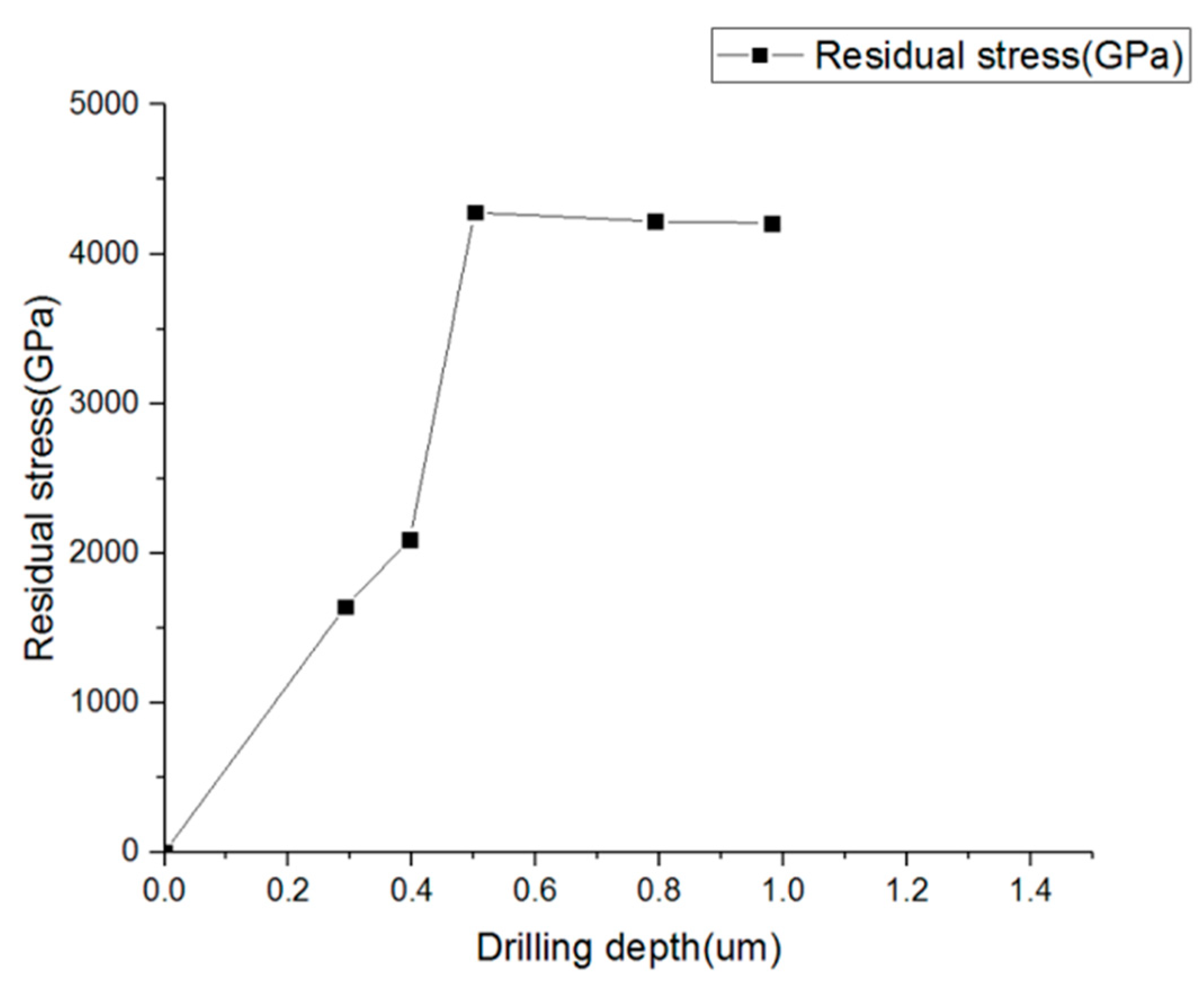1. Introduction
For modern microsystem technologies, it is important to understand the residual stress of thin films, as they might cause some unforeseeable damages or deformation to the components because of the residual stress accumulated during the deposition. It is a great challenge to conduct a reliable modeling and measurement for the residual stress of micro and nanostructured thin films. In order to realize the residual stress in a manner that considers the mechanical anisotropy and the preferred orientation of the materials, the detailed understanding of strain function corresponding to the depth lattice is required when analyzing depth profiles of residual strain [
1].
At present, there are several ways to measure residual stress, which can be divided into non-destructive, semi-destructive, and destructive. Among them, the most commonly used is the non-destructive measurement method, particularly the X-ray diffraction (XRD). The advantage of the XRD method is that it is surface-sensitive and phase selectable. However, the lattice function of the material must be considered, and it cannot measure amorphous materials. Therefore, developing a method for the depth-resolving measurement for the residual stress of the film that is independent of microstructure has become a high-profile issue [
2,
3].
Recently, it is possible to obtain the full-field deformation behavior of thin film materials by using digital image correlation (DIC) on scanning electron microscopy (SEM) images [
2]. Sutton [
4,
5,
6] originally introduced the DIC techniques that calculated the grayscale digital image of the object translation through bilinear interpolation. It was advised that a continuous smooth secondary function can be optimized by the interpolation of a discrete digital image. The grayscale information was used from an integer pixel to a sub-pixel [
7]. Later, in order to solve the six unknown varieties, he illustrated the use of the Newton–Raphson method, which was setting an initial guess value before the iteration method. This method has solutions that convert appropriate range and allow variables to be found more efficiently [
6]. Recently, there is a new method to rebuild the image, which is named bi-cubic spline interpolation. The usage of bi-cubic spline interpolation was found to be more accurate than that of bilinear interpolation [
7]. Here, by combining digital image correlation (DIC) techniques and focus ion beam (FIB) [
2,
3], it is possible to measure the residual stress through the independent procedure of ring core drilling for the resolving depth method without any knowledge of the crystallographic and phase structure of the thin films. Korsunsky et al. [
8] and the following [
9,
10] opened up to report the state of the art in depth profiling by FIB-DIC micro-ring-core (equi-biaxial and general). Later, Lord et al. [
11], Archie et al. [
12], and Salvati et al. [
10] provided very good practice guidelines for FIB-DIC measurements for micro-nanoscale thin films. Recently, Korsunsky et al. [
13], Renzelli et al. [
14], Bemporad et al. [
1], and Siavash Maraghechi et al. [
15] illustrated the standard practice guidelines for FIB-DIC measurements for thin films and coatings with different fabrication processes and tailored residual stress profiles. Each of these papers has its merits and provides very useful information in studies of the applicability of the DIC technique and image correlation and related measurement errors. In general practice, the development of best practices for SEM image acquisition for DIC application may face many complex problems. In particular, it is not easy to correctly implement these images when DIC is implemented. One of the major problems is the application of a reliable pattern on the sample surface for the tracking of one image to another. Kammers and Daly [
16] illustrated the DIC methods of SEM images and noted that more complex issues may be encountered by using limited SEM surface image patterns and pixels to correctly implement these techniques. Despite a high-quality pattern that can be artificially utilized for a better observation, the mechanical behavior of sample structures may be influenced because of the patterning procedure. The high magnification of SEM introduces the complex image distortions. The long scanning time for each image captures high-sensitivity noises; moreover, it will drift from SEM parameters. As a result, an appropriate development scheme for the digital correlation of SEM images with natural surface features is essential. Siavash Maraghechi et al. [
17] pointed out that the SEM images may have a significant amount of imaging artefacts. This situation could generate localization distortions in the displacement fields obtained from the images analyzed by DIC [
17]. Despite many research studies on the DIC of SEM [
1,
2,
4,
13,
14,
15,
16], the computational accuracy and the speed of advancement are always the major subjects. Prior to this, a study was performed on the validation methodology of DIC for SEM to reduce errors and use it for strain and surface deformation measurement of Complementary Metal-Oxide-Semiconductor Integrated Circuit (CMOS IC) samples. This DIC method and its parameters on SEM images were validated for testing under spatial translation or time [
18]. In the study, the stability, accuracy, and speed of calculation were compared by utilizing various image correlation criteria; the accuracy and stability of Zero-Normalized Sum of Squared Differences (ZNSSD) and Sum of Squared Differences (SSD) of DIC were studied. The results of applications in real SEM images of ICs were guided for the standard choice of analysis parameters in application of the full-field displacement measurements.
In this study, the digital image correlation method with the appropriate image correlation criteria suggested in the prior study using ZNSSD was performed to acquire more stable and accurate specimen images. By using incremental focused ion beam (FIB) ring-core drilling with different depth steps, the images were captured and correlated. The FIB-DIC method allows calculating the full 2D displacement field within the gauge area and the surface strain obtained from the digital image correlation method on SEM images. Then, using the proper form of Hook’s law on the measured displacement field leads to the evaluation of the residual stress field of thin films. The study used a ring core drilling measurement method, which can be applied to crystalline and amorphous materials. Further, in order to measure the relaxation strain when the material was milled, the semi-destructive measurement methods were performed.
2. Method
In the DIC method, the constraints of the sample were modified by the milling process disrupting the equilibrium state and leading to deformations within the gauge volume. It was assumed that the feature points on the surface of the object were consistent with the deformation of the object; therefore, the relative position of the feature points on the surface of the object had been analyzed by the image before and after the deformation, and the amount of deformation was obtained. The center point of a subset on the surface of the object is P (x
0, y
0), and a point inside the subset is Q (x, y). When the object was deformed, the new coordinate of this point is (x′, y′); such was the relative position before and after the deformation, as indicated in
Figure 1. The x′ and y′ can be expressed as:
where u (x, y) is the horizontal displacement of the object deformation, and v (x, y) is the vertical displacement of the object deformation.
Previously, the measurement stability, accuracy, and speed of calculation using different image correlation criteria of DIC on SEM images were investigated [
18]. The accuracy and stability of ZNSSD and the Sum of Squared Differences (SSD) of DIC were compared. The results were used to measure the accurate full-field displacement here. For the first SEM image, the full fields in the region are all at 0. This image was compared with the SEM image of the sample after deformation. The full-field displacements of each image analyzed by DIC are the difference between the whole image and the first surface SEM displacement. The DIC images we used in this study have the scale of 120 pixels per micron, which is 120 pixel/μm of the displacement fields.
For the FIB-DIC, the principle of drilling is mainly based on the change in the shape of the object caused by the release of stress in the ring core. The strain of the subject released after drilling and the surface residual stress were calculated using the theory of elasticity.
Based on the principle of fundamental mechanics, the stress components perpendicular to the Z direction of the surface, such as σxz, σyz, and σzz are all zero; therefore, the stress on the surface at the time of drilling is in equilibrium, which must be redistributed and released.
If a circular core with a radius
is subjected to a uniaxial plane tensile stress
σx on the plate, as shown in
Figure 2, the stress state around the circular core can be divided into the superposition of
Figure 2a,b.
By substituting the known three angles and the three strain values in
Figure 2, the stress state of P (r, β) before milling can be calculated using the following [
3,
19]:
where
is the stress component along the r direction before milling,
is the stress component perpendicular to the r direction,
is a uniaxial plane tensile stress,
is the shear stress, and β is the angle between position vector P and
direction.
The stress of the plane does not only include a single axial stress, but other stress in the same plane and another axial stress was also considered, as shown in
Figure 2. Under the theory of elasticity, the principle of superposition can be applied to the stress state, which is expressed as:
The residual stress components
σγ′ and
σβ′ at the point P (r, β) are expressed as:
where
is the drilling radius,
is the radius distance from the core center, and
is a uniaxial plane tensile stress.
The relationship between the stress components
σγ and
σβ at point P (r, β) before drilling and the plane principal stresses
σx and
σy are expressed as:
Before and after drilling, the amount of stress changed, and the amount of stress released at P (r, β) was calculated using:
According to Kabiri’s [
3], the radial strain Δε
γ was measured because the radial strain change is much larger than the circumferential strain change Δε
β, so the circumferential strain can be neglected; therefore, the biaxial Hooke’s Law for stress–strain conversion was used in this study, which is expressed as:
where ν is the Poisson’s ratio,
is the drilling radius,
is the radius distance from the core center, A is the correction coefficient,
(
, and B is the correction coefficient,
[
(
−
(
].
Based on the above equation, three different directions of strain values are required. Next, the distances
r and β = 0°, β + φ = 45°, β +∅ = 90°, and the points P (
r,
β), Q (
r,
β +
φ)
, R (
r,
β + ∅) were used to obtain the strain, which are expressed as:
If ∅ =
,
φ =
, the simultaneous equations can be expressed as:
For the strain, the three strain values, P, Q, and R were measured at the three different angles denoted as β, β + φ, and β + ∅:
where
is the strain value at the angle β on the
x-axis,
is the strain value at the angle
β + φ), and
is the strain value at the angle
β + ∅).
As a result, the relaxation strain and residual stress after each milling can be obtained.
3. Experimental Procedure
In order to demonstrate the feasibility of the method, two kinds of thin films including a metal and transition metal compound were tested. Ag was used as an example because it is a noble metal and has consistent properties after deposition. ZrN was used as a hard coating compound sample in contrast of metals. Both films were sputtered deposited and analyzed in this work. The sputtering parameters are shown in
Table 1 and
Table 2. During the experiment, a designated thin film layer deposited on a silicon substrate was used as a test piece. The FIB was used to carry out the milling process of the ring-core. The scanning electron microscope was used to capture the milled image, and the displacement and strain of the samples were analyzed by the DIC method, as illustrated in
Figure 3.
The specimen was placed horizontally into the FIB instrument (JEOL, Tokyo, Japan) to have a vertical relationship with the SEM (JEOL, Tokyo, Japan) electron gun, as shown in
Figure 3. For ion beam milling, the specimen was placed perpendicular to the ion beam gun so that the specimen carrier could be milled perpendicular to the ion beam gun. The image resolution, brightness, contrast, magnification, and surface image range correction were adjusted throughout sensitivity tests so that the image can be clearly displayed and can be shot after the next FIB ion beam milling. The ion beam parameters adjusted include the beam, the dose, and the size of the ring to be milled. The beam represents the beam current (pA) of the ion beam. The current level was set at 1–13, as shown in
Table 3. The smaller the number, the larger the current of the ion beam. It is true that the beam also affects the milling time and the flatness of the cut ring. In this study, the beam level used in the experiment was 7 for the Ag film and 10 for the ZrN film after preliminary optimization studies. The beam grade is the current energy (pA) of the ion beam, grades 1 to 13. The amount of energy is related to the flatness of the edge of the milled pattern. The smaller the value, the greater the energy. Here, Ag and ZrN have obtained the best parameter solution related to time and quality through experiments. The dose represents the current per unit area of the ion beam (nC/μm
2). It refers to the time it takes to reach the dose. The higher the number, the longer the time it takes. The optimized dose used in this study was a minimum of 0.1 (nC/μm
2).
Ion beam milling of different shapes and sizes was set according to the needs of the experiment. In this study, the shape of the circular ring used with D0 (3 μm) as the outer diameter of the ring and D (1.5 μm) as the inner diameter of the ring.
For the SEM image and the ion beam parameters, the range in the SEM image was first set. Here, both the SEM of Ag and ZrN thin film were set up at a magnification of 12,000×. Next, the SEM surface image was taken, which served as the benchmark for subsequent DIC image analysis, before the milling of the ring was started. Then, the FIB milling parameters were set to start the milling of the ring on the test piece. After the milling operation, a second SEM surface image was taken, and the shift of the first ring milling was taken after the shooting. After calibration, the second ring milling was done, and the third SEM surface ring image was taken. This procedure was repeated until the film was drilled to the bottom of the film layer. A total of four millings were done and five SEM milling ring images were taken (see
Figure 3). Finally, SEM images were analyzed by DIC.
Since each stage of FIB milling obtained a slight shift during SEM electron gun image shooting, each SEM image of FIB milling had a slight difference in position with the first SEM image of the FIB milling surface. Therefore, an area in the first surface SEM image without FIB milling was selected—specifically, the area in the next FIB milling ring that was not affected by the deformation, for calibration. The same area on the SEM image was framed as the first surface SEM image, and the first frame selection area was used as the reference.
An example on the surface images of sputtered ZrN thin films deformed throughout each step of FIB milling is presented in
Figure 4.
Figure 4a shows the SEM image before the milling. After the drilling, the DIC images for each step were taken by SEM as shown in
Figure 4b–e. The nature surface features were directly used for image correlation. The drift distortion, noises, and time-dependent nature of the SEM images, and the electromagnetic lens effects, were all considered. DIC codes were programed on the SEM images of FIB samples captured. Inside the images, multiple matrices of the unit cubic consisting of 5
× 5 pixels were used for the subset and with the corresponding interval of an additional 3 pixels’ distance to their overlap sizes after deformation to calculate the correlation using a grayscale digital image through ZNSSD bilinear interpolation for the object translation. The fitting tool (cftool function of Matlab) was used for DIC post-processing to obtain the full field displacement graph and strain field.
The residual stress was calculated using Matlab routine codes based on the equations illustrated in the Method section. Compared to traditional measurements, the FIB combined with SEM image observation achieved accurate sub-micron measurements, allowing the milling shape to be adjusted according to the requirements, and greatly shortening the experimental analysis time during the rapid measurement of DIC.
